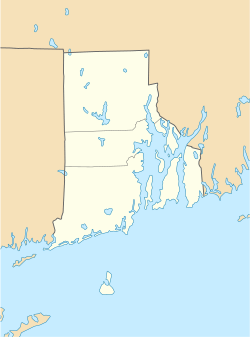Old Colony House facts for kids
|
Old Colony House
|
|
|
U.S. National Historic Landmark District
Contributing Property |
|

The Old Colony House in 2017
|
|
| Location | Washington Sq., Newport, Rhode Island |
|---|---|
| Area | less than one acre |
| Built | 1736-1739 |
| Architect | Richard Munday |
| Architectural style | Colonial |
| Part of | Newport Historic District (ID68000001) |
| NRHP reference No. | 66000014 |
Quick facts for kids Significant dates |
|
| Added to NRHP | October 15, 1966 |
| Designated NHL | October 9, 1960 |
| Designated NHLDCP | November 24, 1968 |
The Old Colony House, also known as the Old State House, is a historic building in Newport, Rhode Island. It stands at the top of Washington Square. Built between 1739 and 1741, this brick building is a beautiful example of the Georgian style. For many years, it was where the government of the colony, and later the state, would meet.
The building looks almost the same today as it did when it was first built. Because it is one of the best-preserved public buildings from America's colonial times, it was named a National Historic Landmark in 1960. This means it is recognized as one of the most important historic places in the United States.
The Old Colony House was the center of many key events during the American Revolution. Famous people like George Washington and Dwight Eisenhower have visited the building. Over its long history, it has been used as a soldier's barracks, a hospital, a courthouse, and even a movie set for a Steven Spielberg film. Today, it is a museum run by the Newport Historical Society.
Contents
Design and Architecture
The Old Colony House was designed by architect Richard Munday. The outside of the building was inspired by the work of the famous English architect Christopher Wren. It is a two-and-a-half-story building made of red brick. The front has seven neat rows of windows.
Above the main entrance, there is a balcony door. The roof has a special feature called a cupola, which is a small dome-like structure on top. The design was meant to create a grand public space, similar to squares in English cities. The first floor was originally an open area for a market, while the government offices were on the second floor.
History of the Building
Before the Old Colony House was built, a small wooden courthouse from 1687 stood on the site. The new building was part of a plan to make Newport a more organized and beautiful city. Placing the government building at the head of the main square, then called the Parade, made it a central point of the town.
The Revolutionary War Era
The Old Colony House was at the heart of many important moments leading up to the American Revolution.
- 1761: A new king, George III, took the throne in Great Britain. The news was announced to the people of Newport from the building's balcony.
- 1764: The first board meeting for the college that would become Brown University was held here.
- 1765: Citizens celebrated in the square when Great Britain repealed the Stamp Act, an unpopular tax.
- 1773: A special group, the Royal Commission of Inquiry, met in the building. They investigated the Gaspée Affair, an event where colonists burned a British ship. The commission could not find enough evidence to charge anyone.
- 1774: As tensions with Britain grew, the colonial government ordered weapons to be stored in the Colony House for protection.
- 1776: The Declaration of Independence was read aloud from the front steps of the building.
During the war, British soldiers took over Newport and used the building as a barracks. Later, when French soldiers helped the Americans, they used it as a hospital. In 1782, the French general Rochambeau hosted a grand dinner there to honor George Washington. A portrait of Washington by Rhode Island artist Gilbert Stuart still hangs on the first floor.
Changes in the 19th Century
After America won its independence, the state capital moved to Providence. However, the state's government, called the General Assembly, continued to meet at the Old Colony House every other year. One day in May, known as 'Lection Day, was a major holiday in Newport. The results of the state elections were announced, and the winners were sworn into office right there.
In 1842, a meeting was held at the Colony House to write a new state constitution for Rhode Island. This was a response to a conflict known as the Dorr Rebellion, which was about who should have the right to vote. The new constitution gave more people, including African-American men, the right to vote.
In 1900, the government stopped holding meetings in Newport. The Old Colony House then became the courthouse for Newport County.
The 20th Century and Today
The building served as a courthouse until 1926. In the 1930s, the Newport Historical Society helped restore it to its original appearance.
In 1957, President Dwight D. Eisenhower visited and gave a speech from the front steps. He praised the city and its history.
In 1997, the Old Colony House became a movie set. Director Steven Spielberg filmed scenes for his movie Amistad here. The building's courtroom was used for the movie's dramatic trial scenes.
Today, the state of Rhode Island still owns the building, but the Newport Historical Society manages it as a museum. It is open for tours during the summer and can be rented for special events.
See also
- List of National Historic Landmarks in Rhode Island
- National Register of Historic Places listings in Newport County, Rhode Island
Gallery









